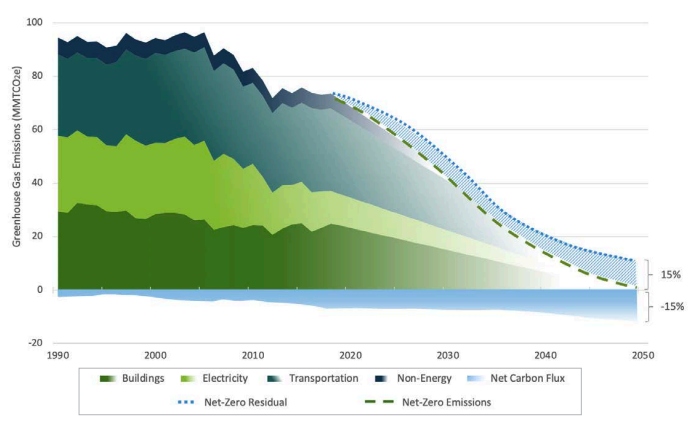CORPORATE TRAVEL SUSTAINABILITY STRATEGY & NET ZERO GLIDEPATH | GLOBAL TECHNOLOGY COMPANY
CLIENT | Global Technology Company

Example of a carbon neutral glidepath illustrating an emission reduction pathway across key sectors
SCOPE | Worldwide Corporate Travel Program
____________________
THE CHALLENGE
One of the world’s largest corporate travel programs—spanning millions of employee trips annually—was tasked to align itself with the company’s broader carbon-neutral commitments. Traditional approaches to business travel were carbon intensive, with few systematic strategies in place to mitigate emissions at scale. The challenge was to design a comprehensive sustainability program and decarbonization pathway that could both reduce climate impacts and enhance traveler wellbeing, while also engaging external partners across aviation, lodging, and mobility sectors.
OUR ROLE
Regensia served as contract advisor and project manager over a four-year period, launching and managing the company’s first Corporate Travel Sustainability Program. In this capacity, we worked closely with internal teams to help:
- Coordinate a Net Zero Glidepath → Established a program-wide carbon footprint baseline, aligned scope and boundaries with the GHG Protocol, developed KPIs, and set science-based emission reduction targets. We also conducted cost-benefit modeling of decarbonization scenarios, with the most ambitious pathway showing potential reductions of 7M+ metric tons CO₂e and ~$700M in savings over an 8 year implementation period.
- Forge Strategic Partnerships → Engaged major airlines, hotel chains, car rental companies, and carbon credit providers to align strategies and co-develop new sustainability initiatives.
- Advance Aviation Solutions → Advised on a Sustainable Aviation Fuel (SAF) strategy, as well as novel mechanisms such as carbon budgeting and offsetting approaches.
- Enable Culture Change at Scale → Created a Sustainable Travel Wiki providing over 1 million employees with accessible tools and resources, and authored white papers that were adopted as precedents across other internal divisions.
KEY FINDINGS
- Business travel emissions can be reduced at scale through coordinated policy alignment, vendor partnerships, and scenario modeling—not just offsetting.
- Integrating sustainability directly into employee-facing resources accelerates cultural adoption and awareness.
- Corporate travel programs can serve as testbeds for broader organizational decarbonization strategies, especially in hard-to-abate sectors like aviation.
RESULTS & IMPACT
The program expanded the company’s leadership in sustainability, positioning its corporate travel function as a benchmark for global peers. It catalyzed measurable progress toward net zero, inspired new industry collaborations, and built internal capacity to embed sustainability into day-to-day business operations.

